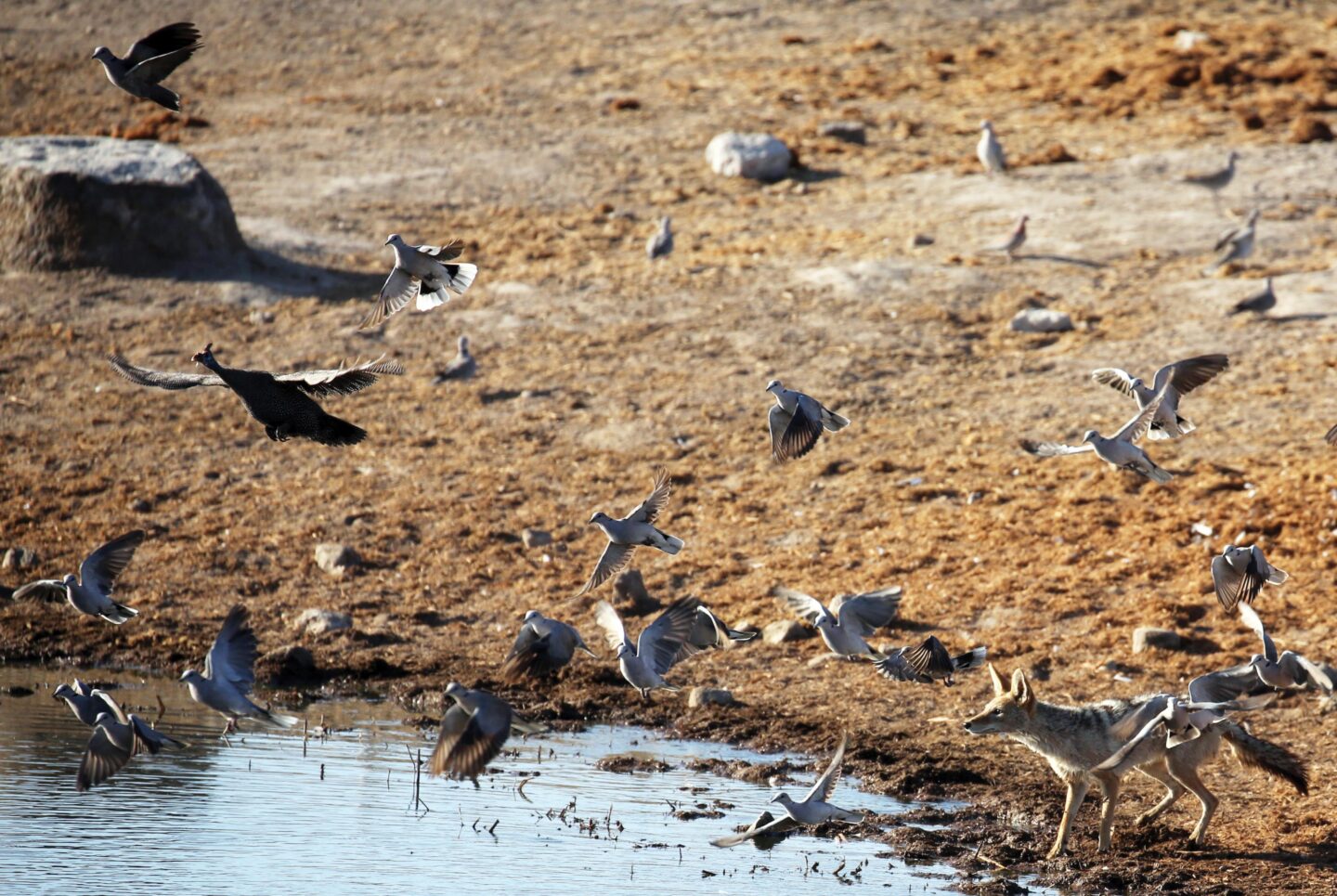

The story of a
dove-hunting black-
backed jackal at Chudop
Early one morning at the end of November 2021 at the Chudop waterhole in Etosha National Park, a black-backed jackal bitch appears. Hundreds of Cape Turtle Doves and a few Laughing Doves, now called Palm Doves, come to drink at the water’s edge. In the usual jackal trot the female moves around the waterhole watching the thirsty doves while keeping a distance of two to four metres from the water. The moment a dove starts to drink, with its back turned towards the prowling jackal, the small predator lowers its head and body and tries to sneak up close to the dove. Most potential victims are too wary or warned by nearby doves taking off. Several attacks end with a splash of water and feathers in the mouth while the prey gets away with a big fright and sometimes the loss of a few feathers.
Text Dirk Heinrich | Photographs Dirk Heinrich
From the Autumn 2022 issue
A gain and again the jackal trots back and forth on the western side of the Chudop waterhole or circles the muddy water. No opportunity is missed but success fails to materialise. She even tries to catch a Little Grebe when it comes close enough to the waterhole’s edge, but the small water bird dives to safety.
Then another try and the next moment an unfortunate dove is caught in a splash. A quick bite and the hapless bird is dead. The jackal quickly comes ashore, bites off the long primary and secondary feathers, pulls off a few mouthfuls of other feathers and swallows the whole dove. Her mate comes closer but feathers are all that is left for him. He sniffs around, urinates on the feathers and moves off.
It is amazing that he does not join the hunt or has adopted the hunting technique of his partner. He watches her from close- by but never interferes.
One dove does not seem to be enough of a meal and the jackal bitch continues with her unique hunting technique. The arrival of giraffe and black-faced impala at the waterhole does not stop her in her efforts but seems to help her closer to her unsuspecting targets.
A few days later the same black-backed jackal is on the prowl again, circling Chudop waterhole. Again she nearly catches a Cape Turtle Dove but is left with a mouthful of feathers after a splash in the water, while dust settles on the dry bank. Moving around the waterhole she suddenly spots a lone Helmeted Guineafowl between the many doves drinking there. Without hesitation the jackal charges the big bird at full speed. Just in time the Guineafowl manages to get airborne together with countless doves. The jackal watches the Guineafowl trying to land on the reeds in the middle of the waterhole. But at more than a kilogram the bird is too heavy and lands on the opposite side of the waterhole.
The jackal immediately rushes over and jumps into the air to get hold of the Guineafowl on its next take-off. The bird flies away from the waterhole with the jackal chasing after it at full speed. After a short flapping flight the bird glides and intends to land. When it realises that the jackal is chasing after it, the bird flaps its wings again, glides, lands and starts running. One sharp turn, then the hunt is over and the jackal has a big meal for the day.
It seemed that this jackal had not hunted a Helmeted Guineafowl for the first time, and it seemed to know that these birds do not like to fly and are not able to fly for more than a short distance. This is why the jackal chased the bird at full speed over two to three hundred metres and was successful.
Black-backed jackals are found all over Namibia except for the far north-eastern parts. Jackals feed on anything from birds, small mammals, reptiles, insects to wild fruit and carrion. Farmers, especially small-stock farmers, kill jackals wherever they get hold of them, because some jackals have learnt, or are forced, to take lambs and sheep. It should be noted, however, that black-backed jackals do play a very important ecological role by controlling pests like mice and termites, cleaning up all kinds of carcasses, catching sick, injured and weak animals, and pairs who bond for life keep their kind at bay. TNN
“Several attacks end with a splash of water and feathers in the mouth while the prey gets away with a big fright and sometimes the loss of a few feathers”






